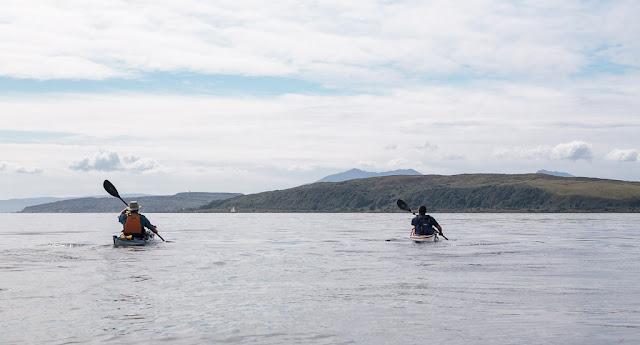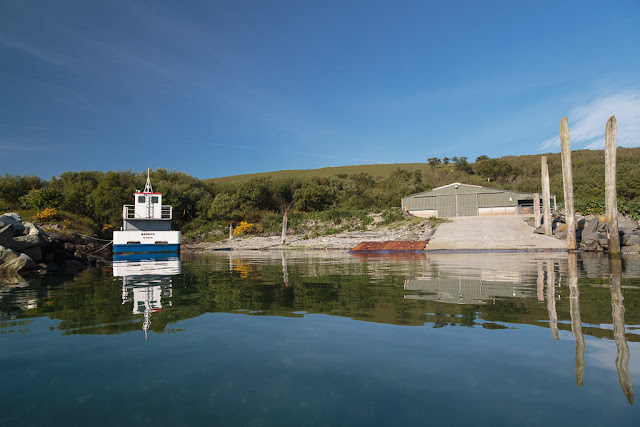We set off from the Little Cumbrae castle on what seemed like the first hot sultry afternoon of summer.
The Arran mountains always delight and the sight of them rising...
...above the reefs of Gull Point is always worth a photo.
Little Cumbrae is composed of layers of lava flows from successive eruptions.
Ian spotted this mimetolith high on the cliffs...Simian Rock.
It was a spring tide so before crossing to Garroch Head across the south going ebb tide...
...we took a north going eddy to just before the lighthouse. This saves a lot of energy maintaining a high ferry...
...angle on the crossing. We enjoyed seeing porpoises and diving gannets but...
...the real treat on the crossing was seeing squadrons of shearwaters skimming the sea round us.
We were welcomed to Garroch Head by a very large grey seal.
Imagine you are at the edge of the sea on a day when it is difficult to say where the land ends and the sea begins and where the sea ends and the sky begins. Sea kayaking lets you explore these and your own boundaries and broadens your horizons. Sea kayaking is the new mountaineering.
Tuesday, August 25, 2015
Sunday, August 23, 2015
Rare doldrums in the Firth of Clyde.
It has been a particularly windy and mostly wet summer here...
...on the west coast of Scotland.
...fun in a whole variety of...
...conditions and in a variety of...
...craft even including a return to...
...windsurfing after a gap of 6.5 years due to my dislocating knees.
I am not interested in sea kayak camping in such weather though so it was with great pleasure that Ian, Mike and I saw a brief weather window open on Monday and Tuesday last week.
So we met at Largs at 1300 hours and spent a little time fitting Ian's new Flat Earth Trade Wind 80 sail to his kayak.
We set off for Little Cumbrae island in a flat calm.
We met the beautifully restored wooden gaff rigged cutter Islay. She was built in 1936 by Cooper of Conyer in Kent. Her construction is of teak on oak so she should be around for many more years. She certainly was not going any where fast and her sails were shaking with the gentle motion of the boat.
We set off across the Tan unsure whether to pass the north or south of the Little Cumbrae island.
In the end a little NW breeze got up so we paddle sailed across...
...from the Ayrshire coast towards the south of the island passing several porpoises on the way.
Passing the Little Cumbrae castle, it was too good an opportunity to miss a...
...stop for first luncheon.
Saturday, August 22, 2015
From the sublime to the ridiculous in the West Kyle.
As the two sides of the West Kyle of Bute gathered towards us we came to Kilmichael. In the field in front of the cottage there is a chambered cairn called St Michael's grave. St. Michael founded a church near by but this cairn predates the Christian era by about 2,000 years.
Just round the coast from the cairn is the ruin of this abandoned house. It was the ferryman's house for the ferry that ran from Kilmichael on Bute to Blair's ferry on the Cowal side of the kyle. Although the rocks look too inhospitable for landing, there is a little cut with a jetty just to the NW of the house. The ferry was established in 1769 and ran until 1940 when it was closed due to WW2 military operations and exercises in the area. The house was occupied until that time. The ferry man operated the premises as an inn called "The Bottle and Glass Inn". Unfortunately we had arrived well after closing time.

The Kames Hotel on the opposite side of the Kyle was open but as it was such a glorious day we decided to stay in the sun for our second luncheon. Amazingly a southerly thermal wind picked up and gave...
Then at the north end of Bute we passed blow two garishly painted rocks known as the Maids of Bute.
As you can see from this close up from our March trip, they look nothing like "maids". I doubt they will be as long lasting as the chambered cairn at Kilmichael.
After a short paddle through the tidal south channel at the Burnt Islands we arrived back...
...at the ferry terminal at Rhubodach just as the MV Loch Dunvegan was pulling away from the jetty. Our four day trip from the Kyles of Bute to Loch Fyne and Inchmarnock was now over. Sadly the Scottish summer of 2015 seemed to coincide with those four days and it would be some time before we went on a camping trip again.
We took the Calmac ferry to Bute from Wemyss Bay then drove from Rothesay to Rhubodach. We covered 91km in 3 whole days paddling.
Friday, August 21, 2015
Inchmarnock to the West Kyle.
We left the lovely but low lying isle of Inchmarnock floating on a wide expanse of limpid sea. It was...
...dwarfed by the high mountains of Arran on the far side of the Sound of Bute.
Our passage across the Sound of Inchmarnock was accompanied by a black throated diver which flew round and round us until it lost interest as we...
...entered the narrowing...
...confines of the...
...West Kyle of Bute.
We took a last look back at Inchmarnock before the last stage of our journey, which would take us on a winding route deep into the mountains where there would be no sign of an open horizon.
...dwarfed by the high mountains of Arran on the far side of the Sound of Bute.
Our passage across the Sound of Inchmarnock was accompanied by a black throated diver which flew round and round us until it lost interest as we...
...entered the narrowing...
...confines of the...
...West Kyle of Bute.
Thursday, August 20, 2015
Seals and boats on the east coast of Inchmarnock.
On the shore below Midpark lie the sad remains of the wooden ferry MV Dhuirnish. The Dhuirnish was built as a turntable ferry in 1956 for J & A Gardner Ltd. who operated the Taynuilt/Bonawe route across Loch Etive until the service closed in 1966. In 1967 the Bute Ferry Co. Ltd. bought her, removed the turntable and fitted a bow ramp. They operated her on the Colintraive/Rhubodach crossing in the Kyles of Bute where she carried six cars at a time. During the Great Storm on the 14th January 1968 she sank at her mooring in Colintraive. She was raised and re-entered.service the following summer. She remained on the crossing until June 1971. By September 1971 she had had two further owners but it is not known how she ended up on Inchmarnock.
Further north we came to the modern farm buildings and slipway at Northpark where the MV Marnock was moored. She was built on Bute in 1999 for the Inchmarnock Estate who...
...rear a pedigree herd of Highland cattle here.
It was now too hot for our dry suits so we landed near the north of Inchmarnock to disrobe.
No sooner had we landed than an inquisitive group of about 30 common seals surrounded us.
The water looked so inviting that I joined them for a quick swim.
This fellow was not for moving, despite the interest shown by his fellow members of the Welcome to Inchmarnock committee.
Feeling much cooler we continued on our way towards...
...the north of the island where...
...a large rocky spit makes a good place to land to explore the north of the island. It was near here where the stone cist containing the 4,000 year old remains of the "Queen of the Inch" were found.


















































